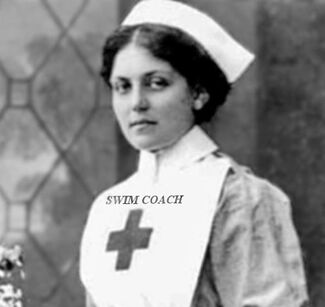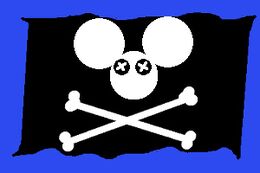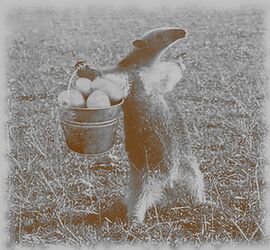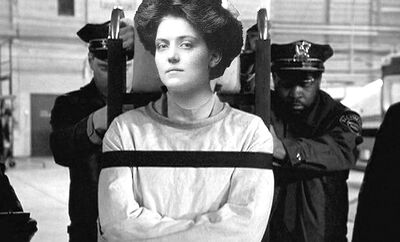Violet Jessop
Violet Constance Jessop (2 October 1887 – 5 May 1971) was a ship stewardess and nurse dubbed "Miss Unsinkable" after surviving three major ship accidents including the sinkings of RMS Titanic and HMHS Britannic. Controversy surrounds her as to whether she was a Jonah, a curse to any ship she was aboard, or someone possessing incredible luck. Survival experts argue to this day over who was the better floater: Jessop, The Unsinkable Molly Brown or your bog-standard duck. Several experts point to Jessop's floaty bits as being key to her survival. Other historians note that the first liner she left, RMS Olympic, became a remarkably adept survivor by shrugging off collisions with 3 major vessels, a torpedo attack and a hentai assault by a kraken. Further, they are of the opinion that her powers, whatever those might have been, would have qualified her to join the Golden Age version of the Justice League of America.
Early life
Violet Jessop was born in Bahia Blanca, Argentina, the oldest of six surviving children. Her parents were Irish immigrants with her father keen on teaching Argentine ostriches to dig potatoes. After her father found that there were no native ostriches in the country and the zoos had none to lend, he died of a broken heart while trying to re-train anteaters to dig potatoes instead of tearing apart anthills and termite mounds.
Her mother, Katherine Mary Madonna, then decided to move the family to England as she was forever suspicious of a place that didn't have long stretches of cold, overcast and rainy days. Buying a large rowboat, the family set out across the Atlantic, making good time. 16-year-old Violet was tasked with encouraging the younger children by singing Row, Row, Row Your Boat and giving them candy rewards. As she watched ship after ship pass them, Violet hit upon an idea which was approved by her mother. As the next ship, S.S. Nostromo, passed close by to hail the rowboat, the Jessops sprang into action. Quickly raising the pirate flag that Violet had neatly stitched together, the other children swam to the Nostromo. On a sugar high from extra sweets, they rampaged through the ship and in less than half an hour, the ship's captain had had enough and surrendered. The ship was taken to somewhere around Cornwall, never to be seen again. The Jessop family moved north as Cornwall was judged to be too sunny.
Passing through Liverpool one time, the young woman saw several nearly-finished ocean liners and decided then and there to work aboard one of them. She was thinking of becoming a coal stoker as befitted her Irish heritage, even buying a new shovel. However, her new English friends Gerda von Ribbentrop and Molly Goldberg convinced her that a ship stewardess job might be a better choice. Jessop flipped a coin to decide. It landed on edge. Nonetheless, she set her cap to become a stewardess.
Early career and controversy
After interviewing with two passenger lines it became clear that she was considered to be too young and good-looking for the job. Further, since she would be attending the upper classes, her cheeks were not deemed thick enough to take the punishment of daily slapping for mistakes real or imagined. Jessop then uglied up to look older[1] and stuffed cotton in her cheeks for her next interview with the Royal Mail Line. It was a productive meeting that left her in consideration with another woman for just one position. As fate would have it, the other woman was eaten by a crocodile given to her as a carnival prize just before her second interview. So, Jessop was hired at 21 for a job aboard the RMS Portmeirion. The ship was in transatlantic service to Buenos Aires so Jessop was often able to visit with several of the anteaters that worked for her father. Coincidentally, those anteaters would go on to form the workers party that later brought Juan Perón to power.[2]
Portmeirion had no problems crossing the Atlantic thought to be due to its innovative balloon escorts. Yet it was found that, particularly around the Bermuda Islands, no other vessel crossing the area had ever been seen again. In a Royal Navigational Board enquiry, all crewmembers were subject to questioning including Jessop. The stewardess had been seen on deck on more than one occasion waving to passing ships that disappeared into mysterious fog banks and were never seen again. Under pressure, she admitted that Cthulhu was a family friend and no more, though investigators clearly thought the relationship was a "bit more personal than that". She was cleared of any suspicion when Lord Admiral Nyarlathotep spoke on her behalf. Though her employers were sympathetic, they were forced to let her go as they only had the one ship left and others had seniority. Whilst amply qualified, Jessop declined to join the redundancy program then available for Irish folk with shipboard experience. This involved holding a large target in a rowboat for battleship gun practice.
Aboard RMS Olympic
As luck would have it, Jessop was able to land a stewardess job with the prestigious White Star Line in 1910 aboard the newly-built luxury liner RMS Olympic. She took to this job with gusto, befriending wealthy but vulnerable dowagers and beating them at various games with marked cards and slick dealing. This would prove to be dangerous as some were cheats themselves with weapons, spy mirrors and worst of all, midget assassins hidden in hat boxes.
Then one fateful day, she heard a loud crash and felt a cool ocean breeze in her cabin. The cruiser HMS Hawke had collided with Olympic[3] as both were racing to the docks to get to the local chip shop before it closed. Though damaged, the Olympic made it to the dock without further incident. After a board of enquiry was assembled, it was determined that Jessop was closest to the point of impact and was thereby deemed responsible for the accident. With the official judgment that she had "willfully failed to keep the middle bits of the boat out of harm's way", Jessop was fined £5 plus VAT and given a reprimand. Later it was found that stoker Arthur Priest was equidistant from the damage and her penalty was reduced by half.
RMS Titanic
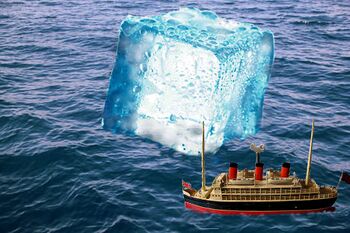
With the Olympic under repair, Jessop, Priest and other crewmembers decided to transfer to its new sister ship, RMS Titanic. On boarding, they were immediately struck by the fact that the ship was a twin of their previous ship. They also noticed it only carried 16 lifeboats with half marked for the personal use of White Star Line executive J. Bruce Ismay.
After a stirring game of whist where she won 5d, the stewardess was nearly asleep on the night of 14 April 1912. Looking forward to another day of barked orders and physical abuse, Jessop was stirred fully awake by a loud noise. She was confused as to why there was several hundred pounds of ice delivered to her room but no flavoured syrups to go with it to make snow cones.
She was soon roused by her supervisor and tasked with bringing armloads of towels down to the engine room to assist housekeeping. She later recalled the fourteenth trip being easiest of all as at that point she only had to travel down one flight of stairs to get to water level.
Jessop was then called to the boat deck to demonstrate to passengers how to fasten their lifebelts and board a lifeboat. She was then directed to dance the Charleston, do several bird calls and perform an imitation of the captain running in circles and screaming like a little girl. After a short round of applause she was tossed into lifeboat 16 with a wrapped loaf of bread[4] and a baby in a blanket handed to her at the last minute.[5] She would later be fined £2 for excess baggage.
As her lifeboat was rowed away from the sinking ship, the stewardess reported that she heard and saw an "obnoxious woman blowing a whistle completely out of tune". She recognized stoker Arthur Priest in nearby lifeboat 15 and asked to borrow his coal shovel to do in the whistle-lady, but the latter had drifted out of sight.
Taken aboard RMS Carpathia Jessop was immediately set upon by two women, one who snatched the baby and one who took the loaf of bread. A surprised Jessop could only hope that the woman brandishing a knife was the one with the bread. Upon landing in New York, she then organized card and bingo games and won thousands of dollars. The stewardess then took all the winnings and stuffed it all into a survivors fund donation box. That box later turned out to be a fake put in place by J. Bruce Ismay.
It was also found afterwards that Jessop had won the ship's daily mileage contest. However, as she was required to present her winning ticket to Titanic's pursers office, she decided her swimming and diving skills were not up to snuff to collect the money.
Many years later, Jessop received an anonymous telephone call with the caller asking if she remembered the "parcels" she carried in Titanic's lifeboat. The caller then stated "I was one of those parcels", chuckled and hung up. Only later did Jessop recognize the voice – it was the Pillsbury Dough Boy putting on a fake Cockney accent.
In war service aboard HMHS Britannic
After Titanic, Jessop volunteered for the Red Cross in 1915 and was immediately assigned to HRMHS Britannic, coincidentally a White Star liner converted to a hospital ship. Her friends saw her off, dragging her kicking and screaming to the gangway and up on board. Visitors to pier 39 today can still see her claw marks on the dock. Jessop finally calmed down when reminded she would be in the Mediterranean far from any iceberg. She also saw Arthur Priest wave to her as he was being dragged down to his station in the boiler room and conceded "What are the odds?"
Adjustment was difficult for the transfers from Olympic and Titanic since they now carried a reputation as Jonahs, with the word neatly stenciled on their foreheads by the Royal Navy for easy reference. Jessop also noted that it was very hard to get any work done with all the patients wearing life jackets and sitting in a ready lifeboat in the ship's infirmary. Whenever she entered a ward, all patients whether mobile or not would immediately don their life vests. Jessop found giving injections was particularly difficult as she always wore two life vests herself at all times.
All was well for several trips until 21 November 1916. Jessop heard a loud explosion and saw a blur run past her doorway, which of course was stoker Priest. As luck would have it, the ship was struck by a mine.[6] Evacuation was by-the-book as there were no patients aboard. However, in attempting to beach the ship, the propellers were left running. Several lifeboats were lowered and sucked toward the spinning blades. A perfectly fine conversation between Arthur Priest and Jessop about growing 4-leaf clovers was rudely interrupted by a propeller shredding their lifeboats. Jessop jumped before being cut to ribbons. As she tried to surface, she hit her head on the ship's keel. After hearing of this later, White Star fined her 1/6 for scratching the paint. Priest, also surviving again, lost his cap but was only docked 3d for it.[7]
It would be years before Jessop would connect the incident to her constant headaches and related hallucinations of mobs of badgers doing deep knee bends.[8]
The dry years
Now at a crisis point in 1917, Jessop decided to see if she should seek a different line of work. Once again, she tossed a coin into the air. This time, it was struck by lightning and completely vaporised. Taking this as a sign, she crawled under her bed and didn’t emerge for six months. However, by necessity, she went back to work as a stewardess, tempting fate by eventually signing on to the Belgenland for two around-the-world cruises. While there were no sinkings, much to the relief of the shipping lines involved, historians point to several volcanic eruptions that apparently followed the path of that ship.
In 1950, she retired to Surrey and wrote her memoirs, aided by writer John Maxtone-Graham who coined her nickname “Miss Unsinkable”[9]. Jessop raised chickens, running them through weekly lifeboat drills out of habit, until she was shot to death by one of the chickens during a supposedly friendly game of cards.
Footnotes
- ↑ Zsa Zsa Gabor Method
- ↑ later purged when Eva "Evita" Perón was found to be allergic
- ↑ Hallo, sailor!
- ↑ thought to have been her prize
- ↑ not a prize, apparently
- ↑ or vice versa. Greedo shot first.
- ↑ Arthur Priest would later escape two more ships, sunk by torpedo attacks during World War I, though nobody called him unsinkable. In fact, after that, no one trusted him around a glass of water.
- ↑ now found to be quite common with older people
- ↑ Later made into the song, You're Unsinkable, That's What You Are
| Featured version: 19 May 2018 | |
| This article has been featured on the main page. — You can vote for or nominate your favourite articles at Uncyclopedia:VFH. | |
